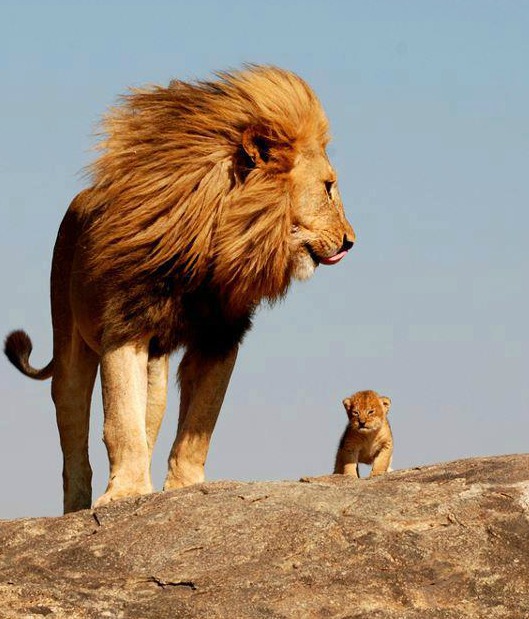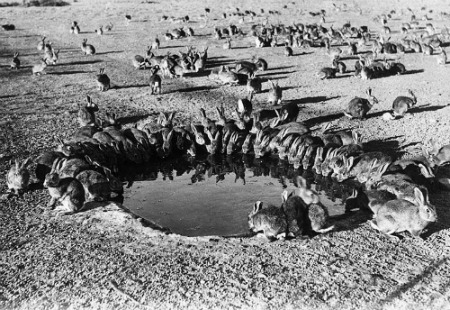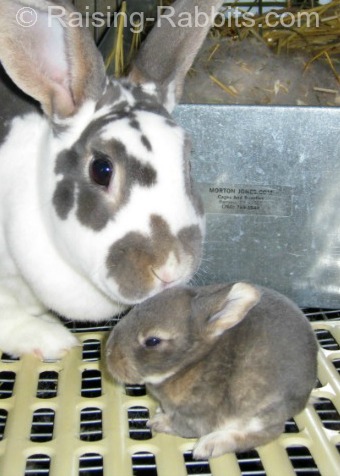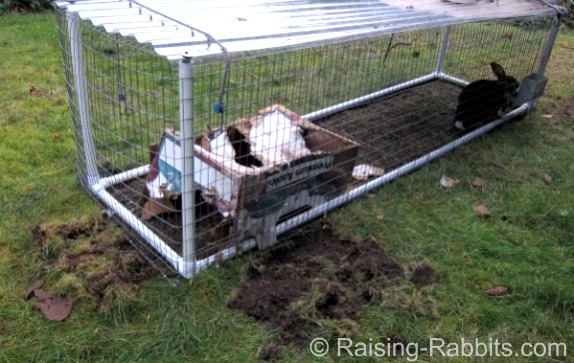Predator Prey
Predator Prey. Every ecosystem where rabbits exist needs rabbit predators to control the rabbit population. A lack of balance between predator and prey results in serious consequences.
Our minds know that rabbits are prey animals.
But our hearts haven't got the memo. Many humans have a very hard time viewing rabbits as prey.
Rabbits have baby faces, large eyes and ears, rounded
bodies, and an oh-so-cute button nose. Rabbits exude a sense of helplessness,
which along with their cuteness triggers within us a nearly overwhelming desire
to protect and to love these delightful creatures.
This is despite the fact that we know rabbits are prey animals in the wild. No matter - the very idea that ANYTHING should devour these beautiful rabbits is horrifying to some – a completely understandable reaction.
Nevertheless, let’s steel ourselves for a moment in order to see what real life looks like to rabbits, and especially their role in predator prey relationships.
Rabbits are consummate prey animals capable of multiplying almost uncontrollably. Therefore the species manifests a dark side if the predator prey balance is ignored and the rabbit population explodes.
Whether or not you ever plan to add rabbits to a meal plan, it is important for pet rabbit owners and rabbit breeders alike to understand the big picture and take lessons from the quickly multiplying rabbit.
Rabbit Multiplication: 1 + 1 = 153
Wild European rabbits (Oryctolagus cuniculi) – our domestic rabbits – have the capacity to breed and multiply at a dizzying pace, depending on the availability of forages within the ecosystem. In springtime when the grass is fresh and young shoots are plentiful, does can breed and bear litters nearly every month.
Where can I find top quality rabbit cages that are great for rabbit feet?
From Raising-Rabbits, of course!
Raising-Rabbits has partnered with Hostile Hare to bring you cages that exceed our rigorous rabbit housing standards.
We do not manufacture cages, but we sure recognize a well-built, predator-proof, baby-safe, bunny-feet-safe cage when we see it! We think Hostile Hare cages will serve you well for years.
Explore the choices by clicking the logo or this link!
Rabbit Survival Rates
Whether we like to think about it or not, rabbits ably fulfill their role as prey animals.
Predation of unweaned bunnies is high, perhaps as high as 50 – 75% of bunnies up to age 4 weeks. The average lifespan of a rabbit that survives beyond weaning is just 18 months.
In a study conducted in the 1950’s, researchers calculated the survival rate of 124 rabbits according to age group, as follows:
Out of 124 weaned rabbits in a fenced but open
colony…
What Predators Might Threaten YOUR Rabbits?
The vast majority of domestic rabbits
are kept outdoors in various housing situations. Most outdoor rabbits are
either pets, show rabbits or the family’s small meat rabbit herd. The majority
of outdoor rabbits are kept in:
- Wooden hutches, which may or may not be built with predator-safe wire
- All-wire cages, which are still vulnerable to certain predators such as rats and snakes, if they can climb the hutch legs. Plus, many large predators such as stray dogs can and will destroy an all-wire cage if they can gain access to the rabbitry itself
- Colonies, either confined or not well confined. Colonies are the worst when it comes to predator prey vulnerability, as they are frequently open to the air, and easily entered by many types of predators, either by going over a fence or digging under and in.
We don’t know where you live, but in
our opinion, the rabbit owner will do best to know the major rabbit predators
in his area, and ensure his rabbits are securely housed against predation by the
local predator prey chain.
SIX delicious flavors of Bunny Branola...
Just a Tablespoon a Day Can Improve Health and Conditioning

(Pictured
at right: Raccoon prints on our deck on a damp late evening in mid-October.
Raccoons will kill rabbits and chickens in a heartbeat. Since it had no access to our
animals, this raccoon was looking for a free cat food handout. These footprints were
our warning to be vigilant throughout the hungry winter months.)
Rabbit Predators
 Lions and their cubs need to eat too...
Lions and their cubs need to eat too...Many animals are known to be rabbit predators. The following list of predators only scratches the surface:
- Fox
- Dingos
- Wolves
- Coyotes
- Lynx
- Wolverine
- Stray and feral dogs
- Bears
- Rats
- Snakes
- Ferrets
- Feral cats easily catch and kill kits and weak, diseased rabbits, but are not usually strong enough to catch and kill a fully grown healthy rabbit
- Ermine (stoats) and weasels have been seen to pack-hunt rabbits, catching fleeing rabbits as they leave various holes of their interconnected burrows
- Badgers dig kits out of shallow nests if they can find them; they’re not fast enough to give chase
- Eagles, buzzards, harriers, hawks and owls typically settle for kits or weanlings, while the larger birds of prey can carry off full-grown rabbits
- Large carnivores such as big African cats will settle for rabbits as a
snack in between kills of bigger game animals.
Raising-Rabbits: Home of
The Rabbit Raising Problem Solver
All your Answers in One Book!
Learn More Here
$22.62 - Order Here
Sheer terror can kill a rabbit before a predator ever touches it.
Relates rabbit researcher RM Lockley: “I have seen and heard a half-grown rabbit dragging its hind legs feebly and screaming while a stoat was still a dozen feet away and approaching its victim at a gentle amble. This rabbit might already have been diseased, although it seemed to be quite healthy; I rescued it before the stoat reached it, but its eyes were already half-glazed, its heart violently palpitating, and its limbs trembling and uncoordinated. It died within half an hour, apparently of a heart attack on sighting or scenting the stoat.”
This is in accordance with the observations of animal behavior expert Dr. Temple Grandin that rabbits do not fear or sense pain as much as they are terrified of fear itself.
Predator Prey Checks and Balances

The number of rabbit predators in a locale tends to be governed by the numbers of prey animals.
“To maintain the food-chain of grass-eaten-by-rabbit-eaten-by-predator, all the components must survive in ratio that does not threaten any part with extinction”1.
When the prey population drops due either to reduced forages or disease, the predators fail to breed successfully. In areas with an abundance of prey (rabbits), the breeding rate and the numbers of predators rise sharply.
Predators have a typically positive effect on the prey population.
They kill off the weak and the diseased individuals first, generally improving the rabbit colony’s collective genetic gene pool. As RM Lockley observed:
“Those [rabbits] weak enough to become paralyzed at the moment of knowledge of pursuit by a mustelid will automatically be killed or die of fright. The elimination of these weaklings and the survival of the rabbits which are strong or astute enough to escape when so pursued is of benefit to the species; the ability to attempt to escape will be handed down, by instinct or learning or both, to the progeny of the survivors.”
What if Predator Prey Numbers are Unbalanced?
In 1859, the Briton Thomas Austin introduced 12 rabbits into his estate in SE Australia. What he may not have realized was that there were no natural rabbit predators in the area of Australia where he released the rabbits.
By 1907, a rabbit plague stretched from Australia’s west coast all the way to its east coast – a swath of land roughly 2,500 miles wide and hundreds of miles inland. It was the fastest spread of any colonizing animal in the world. How bad was the plague? At areas where long fences had been erected to keep rabbits out, the animals would be so thick against the fence that they could climb over one another, breach the fences and access the greenery on the other side.
Without rabbit predators, an unbalanced ecosystem might eventually look like this:

The above picture was taken on Wardang Island along the southern coast of Australia in 1938. Australia is still trying to control a feral rabbit population that numbers in excess of 100+ million.
Wherever rabbits live, they must also coexist with predators that will hunt and kill them as intended by Nature, or the ecosystem will very rapidly become unbalanced.
It is clear through their capacity to multiply that the
rabbit was specifically intended to be a main prey animal near the bottom of
the food chain in all ecosystems in which they live.
And that is the main difference between our pet dogs and cats, and our pet rabbits.
While rabbits usually give just as much pleasure to their owners as do pet dogs and cats, there is a vast difference between the species. As a consummate prey animal, the rabbit’s status as a pet takes a distant second place to its role as a prey animal both to animal and to human predators.
There are more lessons that pet rabbit owners and rabbit breeders can learn from the predator prey relationship - click to learn more!
Predator Prey Info Source: The Private Life of The Rabbit, by RM Lockley
Double-Value Guarantee
Our policy is to always OVER-deliver
on value,
which is why your purchase is fully covered by our
Double-Value
Guarantee.
Go ahead - take any of our e-books for a test drive. Peruse our detailed informational and educational e-books. Examine our plans for building rabbit cages, runs, or metal or PVC hutch frames. Check out the Rabbit Husbandry info e-books.
If you aren't completely satisfied that your e-book purchase is worth at least double, triple or even quadruple the price you paid, just drop us a note within 45 days, and we'll refund you the entire cost. That's our Double-Value Guarantee.
Note: When you purchase your
e-books, they will be in PDF format, so you can download them to any device that
supports PDF format. We advise making a back-up copy to a drive or cloud
account. If the books are lost, you can also purchase another copy from Raising-Rabbits.














New! Comments
Have your say about what you just read! Leave me a comment in the box below.